

 Terroir, desirable or despicable?
Terroir, desirable or despicable?
It is interesting to see how a word can be reassessed. Take the word terroir. A word that every wine lover uses about ten times a day. And always in a very positive spirit. A wine that tastes of its terroir is a successful wine, a wine that stands out, a wine which reveals its origin. This is the general opinion. When did the meaning of the word change?
In the 1800s terroir taste in a wine was absolutely not positive. Goût de terroir, terroir taste, was found mostly in simply wines and it made them almost undrinkable. A wine with terroir taste was defective, more or less.
The French talked about goût de terroir as late as the 1970s. If you read the New Encyclopedia of Wines & Spirits by Alexis Lichine (Bordeaux-profile and wine book author) from 1974 it says nothing about the word terroir, but the following about goût de terroir: “In French this means, literally, earthy taste; it denotes a peculiar flavour imparted by certain soils, and not the taste of the soil itself.”
Which soils are to blame we do not know. Probably poor winemaking was to blame, not the soils. Now, the meaning of the word terroir has changed. A terroir wine may not always reveal its origin in a blind tasting. But it has something special, which is often difficult to describe. Just as the French dictionary Larousse says in 1982: “goût de terroir gives a distinctive, special, almost indescribable, taste.”
Let us simply say that terroir wines are the opposite of streamlined and boring.
Today it is purely positive with “terroir” and many of the best producers are proud over the terror character in their wines.
You will get many excellent examples of that on our wine tours. The spring program is almost ready and you can find the preliminary dates in the Brief. There is still also some openings to join us on the South Africa tour in March, a tour that now has both a safari and a golf add-on option.
And don’t forget to “like” us on Facebook!
Britt & Per
PS: Recommend to your friends to read the Brief!
What’s on at BKWine Tours
- Champagne, September 14-18
- Bordeaux, September 28 – October 2
- Douro Valley, October 12-16
- Chile and Argentina in South America, January 28 – February 12, 2017
- South Africa, February 24 – March 7, 2017, with Safari add-on and Golf add-on
- Champagne, April 19-23, 2017
- Bordeaux, May 3-7, 2017
For more information please contact us on email or on phone (we’re on French time), or go to our wine travel site on www.bkwinetours.com!
We also make custom designed wine tours – on-demand tours for you and a group of friends, for your company (maybe to scout new winegrowers?), for a special event… We can combine winery visits and wine touring with other activities: gastronomic workshops, visit to an oyster farm, truffles hunting, cheese making, and more. More info on the custom designed and bespoke BKWine wine tours and travel here!
From the World of Wine
In Brief
In short, news and stuff from the world of wine.
Hail destroys vineyards in Langeudoc
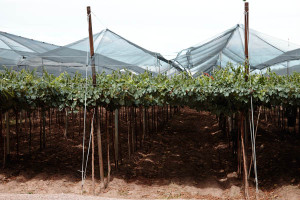 A violent hailstorm caused great damage in among others the Pic Saint Loup and Grès de Montpellier appellations in Languedoc on 17 August. Grapes from hundreds of hectares were completely destroyed. The vines afterwards were completely naked, not a single leaf or grape bunch remained. Some growers lost their entire harvest and the Pic Saint Loup appellation lost between 50 and 60% of this year’s harvest.
A violent hailstorm caused great damage in among others the Pic Saint Loup and Grès de Montpellier appellations in Languedoc on 17 August. Grapes from hundreds of hectares were completely destroyed. The vines afterwards were completely naked, not a single leaf or grape bunch remained. Some growers lost their entire harvest and the Pic Saint Loup appellation lost between 50 and 60% of this year’s harvest.
Hail Insurance may cover some costs and maybe growers will be allowed to buy grapes from other producers in the appellation (as far as anyone has grapes to sell). Normally a grower cannot buy grapes if he does not have the status of a négociant. But in disaster situations like this, the laws can be stretched a little. Read more about hail damage in Languedoc: vitisphere.com
Winter and spring wine tours
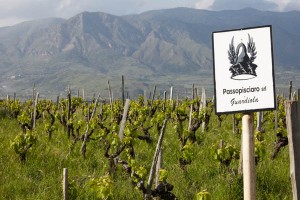 Our winter tours have been on the program for a few months and now we have also finalised our tours for the spring 2017. All details are or will soon be (for Champagne and Bordeaux) on our website www.bkwinetours.com. Here are the dates:
Our winter tours have been on the program for a few months and now we have also finalised our tours for the spring 2017. All details are or will soon be (for Champagne and Bordeaux) on our website www.bkwinetours.com. Here are the dates:
- Chile & Argentina, January 28 – February 12, 2017
- South Africa, February 24 – March 6, 2017
- South Africa, Safari and Wildlife Add-on, March 5-9, 2017
- South Africa, Golf Experience Add-on, February 21-25, 2017
- Champagne, April 19-23, 2017
- Bordeaux, May 3-7, 2017
Small increase in Spanish vine surface
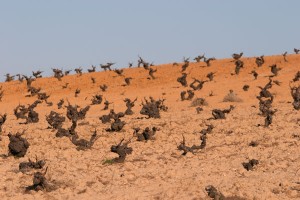 If the Spanish winegrowers were allowed to decide, the Spanish vineyard surface would this year increase by 13 500 hectares. But Spanish authorities, after lobbying from co-operatives and other agricultural organisations, have set the limit at 4,173 hectares, which corresponds to an increase of the Spanish surface of just 0.43%. Other EU countries are allowed to increase their acreage by 1%.
If the Spanish winegrowers were allowed to decide, the Spanish vineyard surface would this year increase by 13 500 hectares. But Spanish authorities, after lobbying from co-operatives and other agricultural organisations, have set the limit at 4,173 hectares, which corresponds to an increase of the Spanish surface of just 0.43%. Other EU countries are allowed to increase their acreage by 1%.
3,400 hectares went to DOP areas of which Rioja received a paltry 387. Rioja probably have many disappointed growers today. New plantings of a total of 5,512 hectares had been demanded. But apparently the Consejo Regulador de la Rioja DOCa wants plantations to be limited as to not risk a devaluation of the brand.
How do you decide who should be allowed to plant? In Spain, they gave priority to young and new growers and to winemakers who could demonstrate “good behavior”(!). Read more: riojawine.com
South African wines gaining ground in the US
Americans drink more and more South African wine and they drink higher quality South African wines. Sales of South African wines in the United States increased by 14% in the past 12 months and the value increased by 25%.
There is an increasing interest in the US at the moment for small South African quality producers who produce exciting and interesting wines. Not least we are happy to see that Chenin Blanc is becoming popular, partly thanks to the grape’s incredible versatility. The light and fresh style of Chenin will attract consumers who usually drink Sauvignon Blanc or Pinot Grigio. And the rich, fat and complex style of Chenin attracts more connoisseur consumers. Methode Cap Classique (MCC), the often excellent South African sparkling wines, have also seen a huge increase in the United States. It is time this South Africa quality trend reaches other countries too! Read more on the US interest in South African wines: prweb.com.
It is a well earned growth. Join us on the wine tour to South Africa in March and you will meet some of the best winemakers in the country.
Setback for blue wine
We must admit that when a blue wine was launched a few months ago we did not think it deserved a mention in the BKWine Brief. It felt too bizarre and somehow so unnecessary. However, now we can tell you about the latest adventure of the blue wine in France. It was recently launched at Auchan, a huge French supermarket, with locations across the country. Its shelf life was, however, destined to be short. Shortly after the launch, the authorities demanded that the wine should be withdrawn. The reason was, they said, that the wine confuses the consumer. The blue colour comes mainly from the indigo plant, but this was apparently not very clearly explained on the label.
The blue wine is called Gïk and was created by five Spaniards. I hope they can use their creativity to something else next time. There are so many high-quality wines in Spain that would deserve a more intelligent marketing effort. Look at that hideous blue colour here: rayon-boissons.com
New classification of Rioja wines?
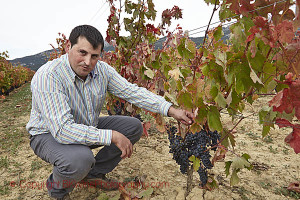 The style of a Rioja wine is determined by whether it is a crianza, a reserva or gran reserva. And the different levels are determined by how long the wine has been aged by the producer, in oak barrels and in bottle. For consumers, this is a way to identify different Rioja wines. But many producers today in Rioja no longer feel comfortable with this classification. If they age their wines for a shorter period it becomes a crianza and thus, they say, less worthy in the eyes of the consumer, despite the fact that the wine may be of very high class.
The style of a Rioja wine is determined by whether it is a crianza, a reserva or gran reserva. And the different levels are determined by how long the wine has been aged by the producer, in oak barrels and in bottle. For consumers, this is a way to identify different Rioja wines. But many producers today in Rioja no longer feel comfortable with this classification. If they age their wines for a shorter period it becomes a crianza and thus, they say, less worthy in the eyes of the consumer, despite the fact that the wine may be of very high class.
Every now and then suggestions pop up that the old system should be scrapped and that producers instead should be allowed to put village names and even vineyard names on the label, much like in Burgundy. Currently, you can only put the three big areas on the label: Rioja Alavesa, Rioja Alta and Rioja Baja. Consejo Regulador DOCa Rioja already has several suggestions to consider. For consumers, a change would be welcome. But in the end it is, as always, the producer’s name that is the most important. Read more on the new proposal for division of the Rioja wines: decanter.com.
Safari and golf as add-ons to the wine tour to South Africa
We have (finally?) published all 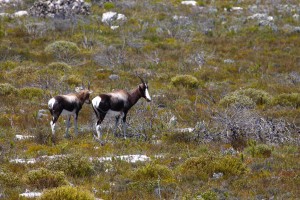 the details on the two exceptional add-ons that you can choose for the wine tour to South Africa.
the details on the two exceptional add-ons that you can choose for the wine tour to South Africa.
Safari: For this very special safari add-on tour we have put together four days filled with several different experiences to show you the incredible diversity of the African nature and wild-life. Instead of spending several days in the same game reserve we will take you to four (!) different wildlife reserves each showing you a different aspect of Africa. More on the safari add-on: Add a fabulous safari experience to your wine tour to South Africa.
Golf: If you are a passionate golfer you should take the opportunity to enjoy a few days on the course when you come to South Africa. For this golf experience we have put together four fabulous days of golfing on four different courses that will show you different aspects of the country and give you very different golf challenges. Read more on this exceptional gold experience: Four fantastic golfing days to add to your wine tour to South Africa.
Two tales from the wine regions in Chile and Argentina
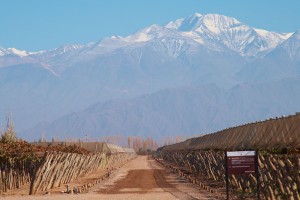 Kathy Merchant, an American wine writer, travelled with us on our latest South America wine tour. She has written two travel stories on what she experienced in Chile and in Argentina, stories that are now published on our travel blog.
Kathy Merchant, an American wine writer, travelled with us on our latest South America wine tour. She has written two travel stories on what she experienced in Chile and in Argentina, stories that are now published on our travel blog.
The world should catch up with wines from Chile! – one can only agree – starts with a quick overview of the wine sector in Chile but moves quickly on to telling you about some of Chile’s most exciting wine producers.
Six Argentinian wineries excelling in quality on the South America wine tour takes a quite different starting point, the roller-coaster ride that Argentina has had as a country over the past century. Today the situation has stabilised and the wine producers are getting into a better position to reach out to the world with their top-class wines. Kathy tells the story of six of them.
Honey from Champagne
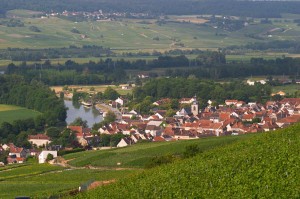 Honey from Champagne, doesn’t it sound delicious? Now this delicacy exists. Well-known Champagne AR Lenoble will release in in September its third vintage of honey from the village of Chouilly. AR Lenoble works environmentally friendly and sees beekeeping as part of having a living environment around their vineyards. The small Champagne house has the environmental certificate Haute Valeur Environnementale (HVE), awarded by the French Ministry of Agriculture.
Honey from Champagne, doesn’t it sound delicious? Now this delicacy exists. Well-known Champagne AR Lenoble will release in in September its third vintage of honey from the village of Chouilly. AR Lenoble works environmentally friendly and sees beekeeping as part of having a living environment around their vineyards. The small Champagne house has the environmental certificate Haute Valeur Environnementale (HVE), awarded by the French Ministry of Agriculture.
AR Lenoble owns 10 hectares in the village of Chouilly and they have planted trees and flowers here and there in the vineyard. The hives were installed in 2014 and they now provide, for the third year, a small amount of honey. In the future, they should be able to make 160 pots of honey. This year’s honey was harvested during the last week of August. Read more about Champagne AR Lenobles’ honey: champagne-arlenoble.com.
We just hope that they don’t start calling it “Champagne Honey”. A French company making patés was recently in a pinch with their “foie gras au champagne”. The recipe did contain the bubbly wine but the Champagne producers’ organisation, CIVC, did not like it and too them to court for using the name champagne on the packaging. The paté people lost and were fined.
We can’t guarantee you honey but there will certainly be plenty of champagne on the wine tour in September.
“It can’t get any better!” says a customer
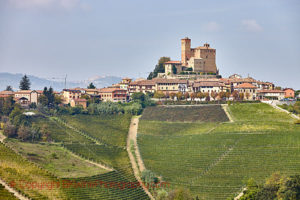 We love hearing from our guest, the travellers, on our tours. This past autumn we had a wine tour to the Piedmont (or Piemonte if we stick to Italian). It had of course plenty of winery visits, vineyards, and tastings but it also included a visit to the famous truffles market in Alba with the exclusive white truffle.
We love hearing from our guest, the travellers, on our tours. This past autumn we had a wine tour to the Piedmont (or Piemonte if we stick to Italian). It had of course plenty of winery visits, vineyards, and tastings but it also included a visit to the famous truffles market in Alba with the exclusive white truffle.
Read more on BKWine Tours’ Travel Blog on the quite extensive customer feedback we had: “It can’t get any better!” – on our wine tours. [divider_flat]
Nyetimber Classic Cuvée 2010, Product of England | Britt’s Wine of the Month
 It’s always fun to find wines that challenge more established wine regions. Like for example Champagne. I tried this English sparkling wine blind at my sister’s and brother in law’s house. Obviously they wanted to set me up. And so they did. My thoughts went directly to Champagne, although I also considered whether it could be something high-class from elsewhere. But my final guess was Champagne, Vallée de la Marne, with a certain element of pinot meunier, because of the delicious fruit. And it turned out to be from England.
It’s always fun to find wines that challenge more established wine regions. Like for example Champagne. I tried this English sparkling wine blind at my sister’s and brother in law’s house. Obviously they wanted to set me up. And so they did. My thoughts went directly to Champagne, although I also considered whether it could be something high-class from elsewhere. But my final guess was Champagne, Vallée de la Marne, with a certain element of pinot meunier, because of the delicious fruit. And it turned out to be from England.
It’s no secret anymore that the English producers can make sparkling wine of very good quality. I will not begin to speculate whether they are as good as or possibly better than Champagne. It doesn’t make much sense. This Nyetimber Classic Cuvée has a fine, toasty and fruity flavour with complexity, a little honey and a good length. And is confusingly similar to a Champagne. Nyetimber grow their grapes in West Sussex and Hampshire, and they grow all three Champagne grapes: pinot noir, pinot meunier and chardonnay. We have previously written on Nyetimber’s sparkling wines on BKWine Magazine.
Features
Features that we have published during the past month, with lots of reading for you.
Meeting Paul Sloan, winemaker at Small Vines Wines in Sonoma
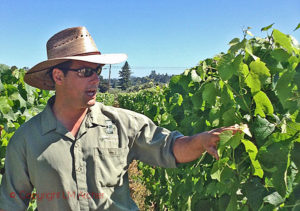 Small Vines Wines is a fairly recent winery in Sonoma, California. A few years back Paul Sloan stood at a cross-roads in his career, should he move to Burgundy to make wine or not? He decided instead to stay in California and make wines inspired by the wines of Burgundy. That was the beginning of Small Vines Wines.
Small Vines Wines is a fairly recent winery in Sonoma, California. A few years back Paul Sloan stood at a cross-roads in his career, should he move to Burgundy to make wine or not? He decided instead to stay in California and make wines inspired by the wines of Burgundy. That was the beginning of Small Vines Wines.
With this article we introduce a new guest writer on BKWine Magazine, LM Archer, who met with Paul Sloan at his winery. Read more on BKWine Magazine: Meeting Paul Sloan, winemaker at Small Vines Wines in Sonoma.
Logan Wines in Orange shows a new side of Australia
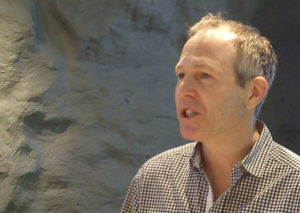 Peter Logan’s father Malcolm began planting vines in Orange 22 years ago and was then one of only five wineries in the area. 2016 marks the family’s twentieth vintage and Peter is the second-generation winemaker. Today there are about 50 wineries in Orange, which the attentive reader notices is ten times more than twenty years ago. The reason for the increase is of course the conditions that Orange offers.
Peter Logan’s father Malcolm began planting vines in Orange 22 years ago and was then one of only five wineries in the area. 2016 marks the family’s twentieth vintage and Peter is the second-generation winemaker. Today there are about 50 wineries in Orange, which the attentive reader notices is ten times more than twenty years ago. The reason for the increase is of course the conditions that Orange offers.
Read more on these interesting Australian wines in Mikael Karlin’s article on BKWine Magazine: Logan Wines in Orange shows a new side of Australia.
A Tasting of Small Vines Wines, Sonoma, California
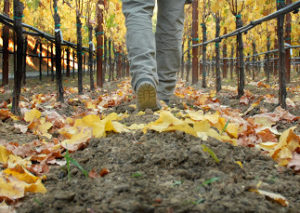 As a follow-up to the article mentioned above on Small Vines Wines we also give you our comments on their wines. Paul and Kathryn Sloan craft exquisite, small lot, grand-cru inspired artisan wines sourced from their sustainably-farmed estate vineyard in Sebastopol, as well as from a few select Sonoma Coast producers. The label on their bottles – a rendering of their vine’s roots and shoots, which mirror one another in height and depth – symbolize Small Vines Wines devotion to balance, both in the vineyard, and in the cellar.
As a follow-up to the article mentioned above on Small Vines Wines we also give you our comments on their wines. Paul and Kathryn Sloan craft exquisite, small lot, grand-cru inspired artisan wines sourced from their sustainably-farmed estate vineyard in Sebastopol, as well as from a few select Sonoma Coast producers. The label on their bottles – a rendering of their vine’s roots and shoots, which mirror one another in height and depth – symbolize Small Vines Wines devotion to balance, both in the vineyard, and in the cellar.
Read more on this in LM Archer’s article on BKWine Magazine: A Tasting of Small Vines Wines, Sonoma, California.
Celebrate with a glass of wine from Brazil | Britt on Forbes
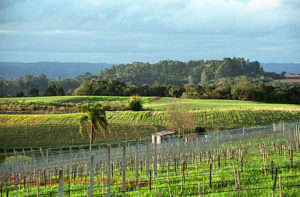 Brazil has been on the front page of every media recently. The Olympic Games does give a lot of attention. But it is rare that Brazilian wines are given much coverage. That is a pity. Brazilian wine has come a long way since the first plantings were done in the Vale dos Vinhedos (The Valley of the Vineyards!) in 1875 by Italian immigrants. Today there is a small and thriving wine production in the far south of Brazil, on the border to Uruguay. In total Brazil has some 80,000 hectares, which equals approximately two thirds the size of Bordeaux. Much of the wine is still vinho de mesa, but more and more are made by ambitions outward-looking wine producers. There is also a very important production of sparkling wine.
Brazil has been on the front page of every media recently. The Olympic Games does give a lot of attention. But it is rare that Brazilian wines are given much coverage. That is a pity. Brazilian wine has come a long way since the first plantings were done in the Vale dos Vinhedos (The Valley of the Vineyards!) in 1875 by Italian immigrants. Today there is a small and thriving wine production in the far south of Brazil, on the border to Uruguay. In total Brazil has some 80,000 hectares, which equals approximately two thirds the size of Bordeaux. Much of the wine is still vinho de mesa, but more and more are made by ambitions outward-looking wine producers. There is also a very important production of sparkling wine.
Read more on this on BKWine Magazine and Britt’s article originally published on Forbes: Celebrate with a glass of wine from Brazil | Britt on Forbes.
The best wine producers in Brazil are in Vale dos Vinhedos | Britt on Forbes
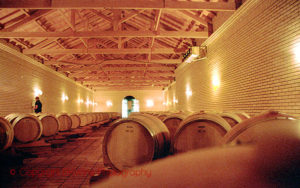 Part two in Britt’s series on Brazil: While the world’s top athletes were fighting it out in the Brazilian metropoles the best wines are made in the very southernmost remote parts of the country, in the Vale dos Vinhedos on the border to Uruguay. Brazilian wines have not yet made a great impression on the world of wine but that is perhaps due to that the country as a whole is a comparatively small wine producer. It comes in as number 15 in the world ranking of wine countries. But there is at least a handful of ambitious Brazilian wine producers that certainly merits your attention.
Part two in Britt’s series on Brazil: While the world’s top athletes were fighting it out in the Brazilian metropoles the best wines are made in the very southernmost remote parts of the country, in the Vale dos Vinhedos on the border to Uruguay. Brazilian wines have not yet made a great impression on the world of wine but that is perhaps due to that the country as a whole is a comparatively small wine producer. It comes in as number 15 in the world ranking of wine countries. But there is at least a handful of ambitious Brazilian wine producers that certainly merits your attention.
Read Britt’s article with some of her favourite and recommended wine producers in Brazil in her latest article published on Forbes. Read more on BKWine Magazine: The best wine producers in Brazil are in Vale dos Vinhedos | Britt on Forbes.
Organic and biodynamic wine book on Amazon
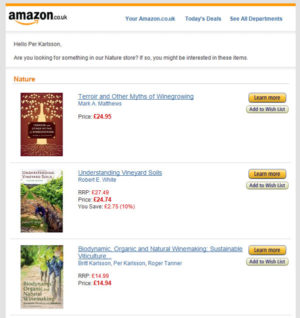 Books from BKWine and two wine university professors… If you are an Amazon customer you know that they regularly come with suggestions of new purchases. I was particularly pleased when I received the promotion email from Amazon with a selection of wine books.
Books from BKWine and two wine university professors… If you are an Amazon customer you know that they regularly come with suggestions of new purchases. I was particularly pleased when I received the promotion email from Amazon with a selection of wine books.
To my surprise I found our very own book Biodynamic, Organic and Natural Winemaking; Sustainable Viticulture and Viniculture, listed together with Terroir and Other Myths of Winegrowing by Mark A Matthews, a professor of viticulture at UC Davis, published by University of California Press, and Understanding Vineyard Soils by Robert E White, who is Professor of Soil Science, University of Melbourne, published by Oxford University Press.
Read more on these books on BKWine Magazine: Organic and biodynamic wine book on Amazon.
Love in the wine at Wrath Wines in Monterey
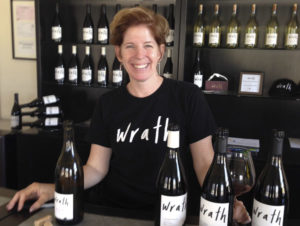 What happens when world-renowned archaeologist Michael Thomas and phenom winemaker Sabrine Rodems join forces in the foothills of Monterey AVA in California? Artisan, bespoke Wrath Wines is what happens. Named in part for the wrath of the gods that set Aeneas upon his journey in The Aeneid, in part from lyrics to Led Zepplin’s “Going to California”. Wrath Wines blend both the sacred and the profane into hauntingly original offerings – some made in terra-cotta urns called dolios – that delight gods and humans alike.
What happens when world-renowned archaeologist Michael Thomas and phenom winemaker Sabrine Rodems join forces in the foothills of Monterey AVA in California? Artisan, bespoke Wrath Wines is what happens. Named in part for the wrath of the gods that set Aeneas upon his journey in The Aeneid, in part from lyrics to Led Zepplin’s “Going to California”. Wrath Wines blend both the sacred and the profane into hauntingly original offerings – some made in terra-cotta urns called dolios – that delight gods and humans alike.
BKWine Magazine guest writer LM Archer sits down for a talk with the winemaker. Read more on BKWine Magazine: Love in the wine at Wrath Wines in Monterey.
Wine tours
Here is some information about current and future wine tours with BKWine.
Powerful and elegant wines from Argentina and Chile on the South America wine tour
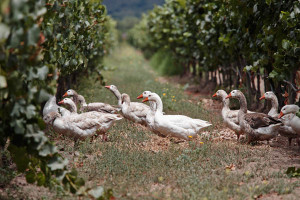 With the snow-capped Andes in the background and an extremely blue sky, Mendoza, the largest wine region in Argentina, is a magnificent sight. The wines are known for their powerful character. But making full bodied wines is not enough any more for the more ambitious Mendoza producers. “We also look for identity, especially for our top wines, it’s very important. We want to have powerful wines, but with the elegance from the old world”, says José Alberto Zuccardi.
With the snow-capped Andes in the background and an extremely blue sky, Mendoza, the largest wine region in Argentina, is a magnificent sight. The wines are known for their powerful character. But making full bodied wines is not enough any more for the more ambitious Mendoza producers. “We also look for identity, especially for our top wines, it’s very important. We want to have powerful wines, but with the elegance from the old world”, says José Alberto Zuccardi.
Also in Chile the producers talk a lot about elegance. To achieve it they look for new locations for their grapes, sometimes close to the Pacific Ocean, sometimes up in the mountains. The results are as stunning as they are in Mendoza. The wines from both countries are gaining in complexity. A reason as good as any to visit these two unforgettable wine countries. The wine tour to Chile and Argentina begins in late January.
Explore South Africa’s many wine regions on the wine tour
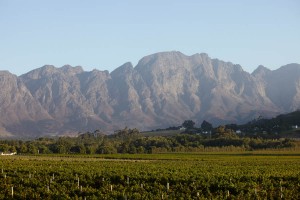 South Africa’s vineyards cover an area of just over 100,000 hectares (a little less than Bordeaux). The production is around 10 million hectolitres, which means that the country ends up as number seven in the world in terms of wine production. The acreage has been stable in recent years. What has changed is that more and more growers are now making their own wines instead of selling their grapes to a cooperative. And, of course, a big change is that the wines have become much more interesting!
South Africa’s vineyards cover an area of just over 100,000 hectares (a little less than Bordeaux). The production is around 10 million hectolitres, which means that the country ends up as number seven in the world in terms of wine production. The acreage has been stable in recent years. What has changed is that more and more growers are now making their own wines instead of selling their grapes to a cooperative. And, of course, a big change is that the wines have become much more interesting!
There are more and more exciting wine regions in South Africa. It takes several trips there to visit them all: Stellenbosch, Paarl, Franschhoek, Constantia, Swartland, Walker Bay, Elgin, Cape Agulhas, Robertson, Tulbagh, Darling, Drakensberg and many more. You have the opportunity to explore several of them on the wine tour to South Africa that starts in late February.
If you have the time, you can extend your stay in South Africa with our fantastic safari tour add-on in the Eastern Cape or with four extraordinary golf days on competition-level courses.
Safari in South Africa – in addition to the wine tour in South Africa
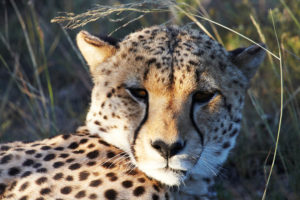 After the wine tour we offer you a four-day trip to private game reserves in the Eastern Cape, one hour flight from Cape Town to Port Elizabeth. The reserves are malaria-free. You will have several exciting game drives, including one in the Addo Elephant National Park. Here they have not only elephants but also the Cape buffalo, the endangered black rhino and a variety of antelope species.
After the wine tour we offer you a four-day trip to private game reserves in the Eastern Cape, one hour flight from Cape Town to Port Elizabeth. The reserves are malaria-free. You will have several exciting game drives, including one in the Addo Elephant National Park. Here they have not only elephants but also the Cape buffalo, the endangered black rhino and a variety of antelope species.
At the Amakhala Game Reserve they have taken a unique wildlife management initiative to reintroduce the animals to the areas where they once roamed free. There will also be a boat ride up the Kariega River where the birdlife is incredible, you will do walk with cheetahs and much more. We can promise you four intense, instructive and very exciting days on this safari extension to the wine tour to South Africa.
Dry, Brut or Nature? Which Champagne do you like best? Choose your favourite on the tour!
Brut is the most common type of champagne today. That means “dry” but in reality there is usually a little sugar in the wine. There can be up to 12 grams per litre but between 6 and 9 is most common. Brut is the Champagne we all drink the most of, it is produced in the largest quantities. Now more and more are extra-brut (maximum 6 grams of sugar) and even drier, Brut Nature (<3 g). And Dry is actually slightly sweeter! Which you prefer is a matter of taste. And it often depends on whether you drink champagne as an aperitif or with food. And it depends not least on how much acidity is in the wine. Champagne is always very fresh. There is nothing more refreshing and appetizing than Champagne!
Discover all these different types of champagnes on our wine tour to Champagne. You will probably realise that you like different styles, not just one style. What is exciting with champagne today is that there is such a variety. Champagne is not only a drink for celebrations. It is a wine with a variety of shades and styles. The tour takes place in September and another one coming in the spring!
Aristocratic and exclusive but also dynamic and forward-thinking, explore Bordeaux on the wine tour
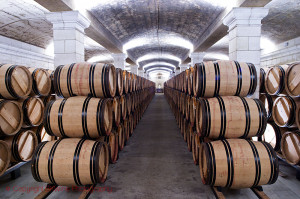 Bordeaux is home to the world’s most famous wines, wines that few of us can afford to drink regularly these days. But you will of course have the opportunity to taste them on the Bordeaux wine tour. But Bordeaux is also home to a young and dynamic generation of winegrowers. There are for instance on the forefront of reducing the use of spraying in the vineyard. There is also a wealth of family owned chateaux that often make wines that are just as excellent as “the big and famous”, but less expensive.
Bordeaux is home to the world’s most famous wines, wines that few of us can afford to drink regularly these days. But you will of course have the opportunity to taste them on the Bordeaux wine tour. But Bordeaux is also home to a young and dynamic generation of winegrowers. There are for instance on the forefront of reducing the use of spraying in the vineyard. There is also a wealth of family owned chateaux that often make wines that are just as excellent as “the big and famous”, but less expensive.
On the wine tour to Bordeaux you will have the opportunity to explore all of this. The next tour is in September and there will be a new tour in the spring time.
It’s worth to make an effort for Dour Wines – wine tour
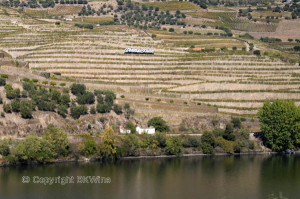 In summer the quicksilver in the thermometer can rise to 40 C (105 F) or even more in the Douro Valley. In October it is much more pleasant, nice summer temperatures actually, and that’s when we have the wine tour to the Douro. But even if it is not so hot, carrying the 50 kg heavy grape baskets up or down the vertiginously step slopes on your back, as they used to do, must have been an ordeal. Well, your task is much more pleasant, taste some of the best wines and best food that Portugal has to offer.
In summer the quicksilver in the thermometer can rise to 40 C (105 F) or even more in the Douro Valley. In October it is much more pleasant, nice summer temperatures actually, and that’s when we have the wine tour to the Douro. But even if it is not so hot, carrying the 50 kg heavy grape baskets up or down the vertiginously step slopes on your back, as they used to do, must have been an ordeal. Well, your task is much more pleasant, taste some of the best wines and best food that Portugal has to offer.
It is curious that even though the Douro River is famous for its port wines, few people know of the other treasures, some of Portugal’s best table wines. You will explore both the ports and the table wines on the wine tour to the Douro Valley in October.
Don’t be an egoist! Share with your friends and other wine enthusiasts! Forward the Brief to your friends! Suggest that they sign up for a free subscription !
© Copyright BKWine






